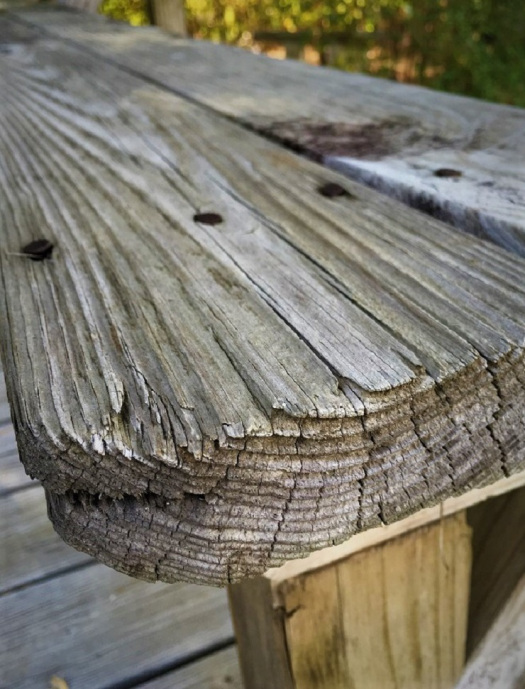In spite of my laid-back approach, sometimes I think I notice little details that don’t bother other gardeners. But have you ever run across a wood deck barefoot, or sat on a wood bench, and got splinters? You can blame whoever put the boards on in the first place.
Not bogging down in all the details, ’cause it’s eye-rolling even to this retired scientist. But in general if you live in a warm, moist climate like mine, wood won’t last long without rotting, and before that happens the boards will probably cup or form raised edges and begin to splinter.
Which way you lay a board can make a difference between smooth and safe, or a butt full of splinters.
Here’s the scoop: Look at the end of a board, and notice the growth rings, which indicate which way the wood was when still inside the tree; because growth rings curve away from the tree center, they will show you which is the outer or “bark side.”
Laying the board “bark side down” will have the growth rings curving down and back up, like a smile. Boards laid this way will stay wet and arch upwards, making a little hill for water to run off either side. Problem is, the edges of each growth ring will get exposed and start to “shell” – to separate and create splinters. This is more a problem with soft Southern pine which, especially in the warm, wet Southeast can rot very quickly unless pressure treated (see *Note below).
 Bark Side Down leads to splinters
Bark Side Down leads to splinters
So most experienced builders are careful to lay boards “bark side up” so the growth rings arch up and back down like a rainbow, which reduces splintering as it ages. That is, unless the other side is prettier. But they all agree that it’s even more important to fasten the boards securely and treat decks and steps every year with a water repellent.
Either way, if you bring it up around the picnic table, you are guaranteed to bore everyone. But when they start to squirm, they won’t get splinters.
*Note: The pressure treatments used today are nowhere near the dangerous chemicals used not all that long ago. In 2003, the U.S. wood treatment industry stopped using chromated copper arsenic (CCA) in non-industrial wood like you buy at lumber yards, and now use safer, more environmentally-friendly treatments. Still, don’t burn it in the fireplace and play around in the smoke.
Share this:





